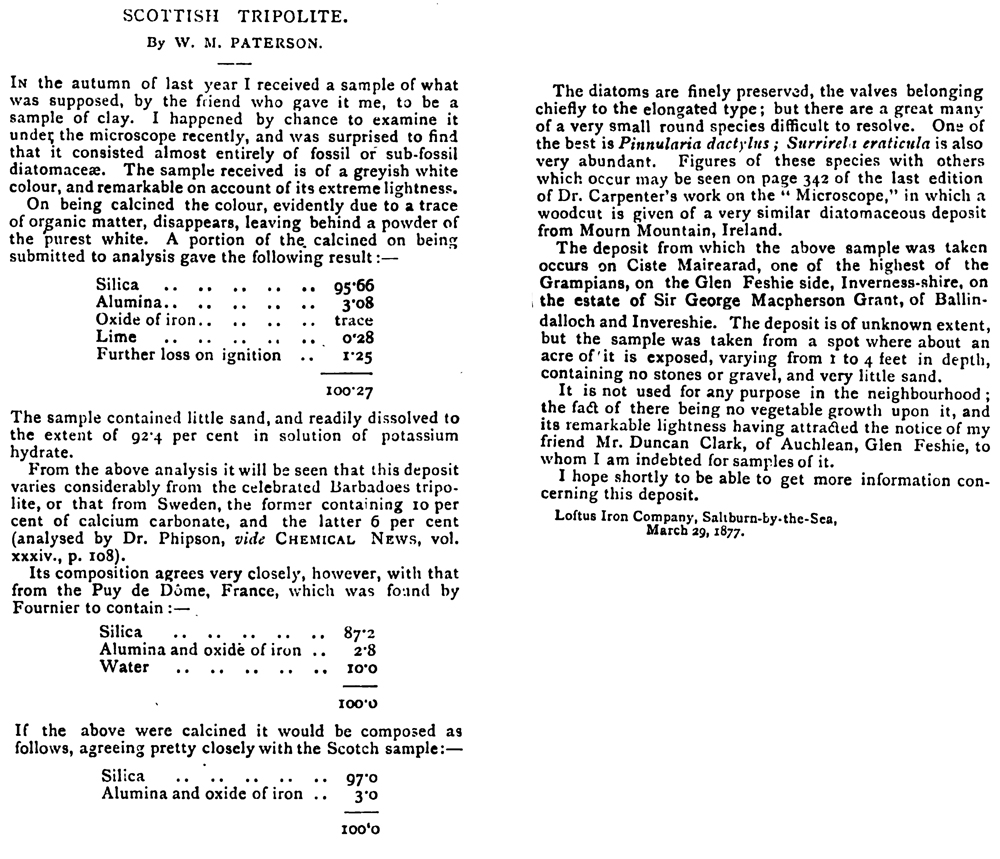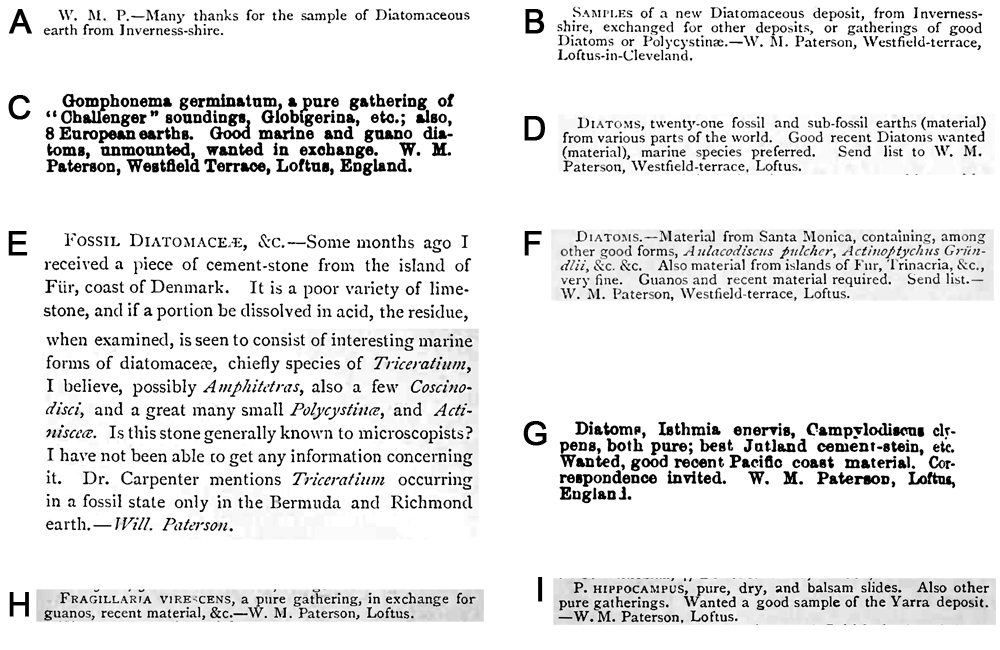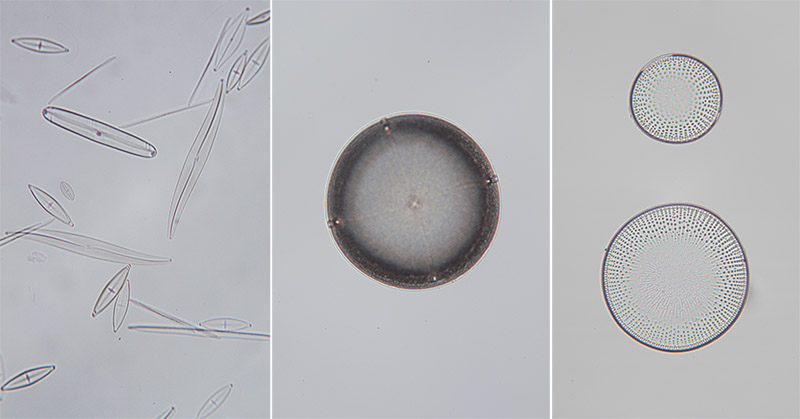Microscope slide maker W.M.P.
probably William Melville Paterson, 1856 – 1884
by Brian Stevenson
Last updated October, 2016
Microscope
slides by “W. M. P.” are relatively scarce (Figure 1 and B. Bracegirdle’s Microscopical Mounts and Mounters plate 41, slide H). The few I have seen are all of diatoms. Two labels are present, similar to those used by William Firth, the Barbour Brothers, and several other late-1800s diatomists. The upper label is machine-printed “diatomaceae”, while
the lower label has the maker’s type-set initials. The handwriting is tidy and
unique. Searches of historical documents indicate that the most probable maker
of these slides was William Melville Paterson, a chemical engineer who lived on
the east coast of England and had a strong interest in microscopic studies of
diatoms.

Figure 1. Three microscope slides of diatoms that were prepared by “W.M.P.”. Left to right: a strew of mixed diatoms rich in Pleurosigma attenuatum collected from the Humber estuary, which is about 80 miles / 130 km south of William M. Paterson’s home of Loftus, Yorkshire; a single, selected Aulacodiscus coberii from guano collected in Pabellon-di-Pica, Chile; and two selected Stictodiscus californicus from Santa Monica, California. Magnified views of the specimens are shown below in Figure 4.

Figure 2. Chemical and microscopical characterization of a diatomaceous earth, from 1877. Written when Paterson was about 21 years old, this is the earliest known evidence of his interest in diatoms and microscopy.

Figure 3. Advertisements and notes from William M. Paterson, all of which regarded diatoms and microscopy.
(A) A note from the editors of ‘Hardwicke’s Science-Gossip’ thanking Paterson for a gift of diatomaceous earth, 1877.
(B)
An exchange advertisement by Paterson, from the same 1877 issue of ‘Hardwicke’s
Science-Gossip’ as A. This diatomaceous earth was presumably the same
characterized by Paterson in Figure 2.
(C)
Exchange offer from an 1878 issue of ‘The American Microscopist’.
(D) Exchange from an 1878 issue of
‘Hardwicke’s Science-Gossip’.
(E) A
descriptive note on the diatoms found in ‘cement stone’ (‘cementstein’) from
Für island, Jutland, Denmark. This became a well-known source of diatoms for
microscopists. From ‘Hardwicke’s Science-Gossip’, 1878.
(F) Another exchange from an 1878 issue of ‘Hardwicke’s
Science-Gossip’.
(G) Exchange
request from ‘The American Microscopist’, 1879.
(H and I) Exchange offers from two different issues of ‘Hardwicke’s
Science-Gossip’, 1879.
William
Paterson was born in Minories, Middlesex, during the winter of 1856. His
father, also named William, was a merchant. William and his younger brother,
James, appear to have lived a fairly comfortable life for a while, as the 1861
census recorded a live-in maid. But, that life took a drastic turn in 1862, when
father William died in April. For the next 15 years, the whereabouts of the two
boys and their mother, Ellen, are unknown, as they have not been located in the
1871 census or other records. Both parents were originally from Scotland, and
Paterson later mentioned having Scottish friends, so it is possible that Ellen
took the boys home. However, they are not identifiable in the 1871 Scottish
census.
Paterson
turned up again in 1877, writing from Loftus, Yorkshire, England, near the
North Sea coast (Figure 2). His letter and the 1881 census indicate that he was
a metallurgical engineer for the Loftus Iron Company, in Saltburn-by-the-Sea.
Paterson’s letter to The Chemical News
described both chemical and microscopic investigations of a diatomaceous earth
sent to him by a friend in Inverneshire, Scotland. He also posted offers to
exchange that raw material with other microscopists (Figure 3 A and B).
William
Paterson apparently had a fair bit of experience in making microscope slides by
1877, claiming to “have mounted many”.
That year he published two brief notes in Hardwicke’s
Science-Gossip on cleaning and preparing microscope slides:
“On Cleaning Microscopic Slides - For
removing Canada balsam from spoilt or useless slides, turpentine is, I believe,
in general use. If the slides be immersed for about two minutes in strong
sulphuric acid, heated to about 100o Fahr., the balsam will be
decomposed into a filmy substance, easily got rid of by washing with cold water.
If the acid is cold, the time will be somewhat longer. Circles of asphalt and
rubber, the deposit of carbon from a lamp, which is sometimes very difficult to
remove by other means, turpentine from beakers, bottles, &c., may be done
in the same manner.—W. M. Paterson.”
“Dry Mounting - I would like to draw the
attention of those readers who are in want of a good method for mounting
objects dry, with asphalt cells, to a method I found out some time ago, and
which I have since used with complete success. The methods to be found in
text-books, at present, are briefly as follows : I. Make a ring, dry it, warm
over a lamp until slightly soft, and having placed the object in position,
adjust the cover. 2. The former method is sometimes varied by making two rings;
the second after the first has dried. 3. Narrow rings of paper are introduced
between the ring and cover, and a few other modifications of these processes.
The whole of the foregoing methods are liable to the objection that the medium
employed for making the cell, asphalt and rubber, or whatever else it may be,
runs in by capillary attraction, and either spoils the object or renders the
slide unsightly. Of the above-mentioned methods, I decidedly prefer the first
one, but I could not depend on it six times out of ten, and have many a time
spoiled both slide and temper. Most microscopists seem to have battled against
the material ‘running in’, a propensity which I have, to some degree, taken
advantage of. Take a slide, and with the turn-table make two narrow concentric
rings of asphalt-and-rubber varnish, the inner one-half, and the outer
seven-eighths of an inch in diameter, and fill up the space between the two
with varnish, so as to make a thin cell of varnish, with an interior a
half-inch in diameter. Dry the slide in an oven, slightly warmed, and when
quite dry, make a narrow ring of varnish on the extreme outer edge of the cell,
and having placed the object in position, or, according to circumstances,
before the first ring was made, adjust a cover, pressing it down slightly. The
varnish is generally only flattened out, and only occasionally spreads to the
edge of the cell encircling the object. The reason for its not ‘running in’, is
simply because very little capillary attraction is offered to the film of
varnish by the dry cell and cover, compared with the capillary attraction
offered to varnish by two plain surfaces of glass, as is the case when the old
methods are employed. When the cover has become fixed, the slide should be
finished by making a ring on the cover, corresponding with the cell beneath. My
experience with this method relates to diatoms and
chemical salts, and I have succeeded so well that I have not yet spoiled a
single slide - and I have mounted many - even including those used in performing
the test experiments. In mounting chemical salts, care must be taken that the
level of the ring is above that of the object.—W. M. Paterson, Loftus.”
Paterson
continued to post exchange offers for the next two years, in magazines in both
England and the US (Figure 3). By 1878, he had acquired a “gathering of ‘Challenger’ soundings”, those being deep water
samplings of microscopic marine life collected by the HMS Challenger between
December 1872 and May 1876. He also offered at least 21 different diatom
gatherings from “various parts of the world”.
I have not
located any exchange offers or other documents of Paterson’s involvement with
microscopy after 1879. The 1881 census showed that he was still in Loftus, working as a “metallurgical chemist” and living with his
widowed mother.
William
Paterson died April 18, 1884, at the age of 27, in Loftus. He was buried,
however, at St. Andrews, Fifeshire, Scotland. The 1891 census recorded mother
Ellen living in Dover, Kent, with her younger son, James, and his family. Ellen
died in Scotland during October, 1896, and was buried in St. Andrews, Scotland,
beside her elder son.

Figure 4. Photomicrographs of the diatom specimens on the slides shown in Figure 1, all viewed with a 25x objective lens and shown at the same final magnification. Left, Mixed diatoms from the Estuary of the Humber River, England. Middle, a single, selected Aulacodiscus comberii from Pabellon-di-Pica, Chile. Right, two selected Stictodiscus californicus from Santa Monica, California, USA.
Resources
American Journal of Microscopy (1878) Exchanges, Vol. 3, pages 48 and 120
American Journal of Microscopy (1879) Exchanges, Vol. 4, pages 24, 48, 72, 96 and 188
Bracegirdle, Brian (1998) Microscopical Mounts and Mounters, Quekett Microscopical Club, London, pages 103 and 186-187, plate 41, slide H
Find-a-Grave (accessed January 2012), William Melville
Paterson, http://www.findagrave.com/cgi-bin/fg.cgi?page=gr&GRid=68847084
Paterson, William M. (1877) Dry mounting, Hardwicke’s Science-Gossip, Vol. 13, pages 160-161
Paterson, William M. (1877) On cleaning microscopic slides, Hardwicke’s Science-Gossip, Vol. 13, page 38
Paterson, William M. (1877) Scottish tripolite, Chemical News and Journal of Industrial Science, Vol. 35, pages 151-152
Paterson, William (1878) Fossil diatomaceae, &c., Hardwicke’s Science-Gossip, Vol. 14, page 112
England census, birth and death records, accessed through ancestry.co.uk
Hardwicke’s Science-Gossip (1877)
Notices to correspondents, Vol. 13, page 120
Hardwicke’s Science-Gossip (1877)
Exchanges, Vol. 13, page 120
Hardwicke’s Science-Gossip (1878)
Exchanges, Vol. 14, pages 72 and 168
Hardwicke’s Science-Gossip (1879)
Exchanges, Vol. 15, pages 96 and 264
Scotland census records, accessed through ancestry.co.uk



